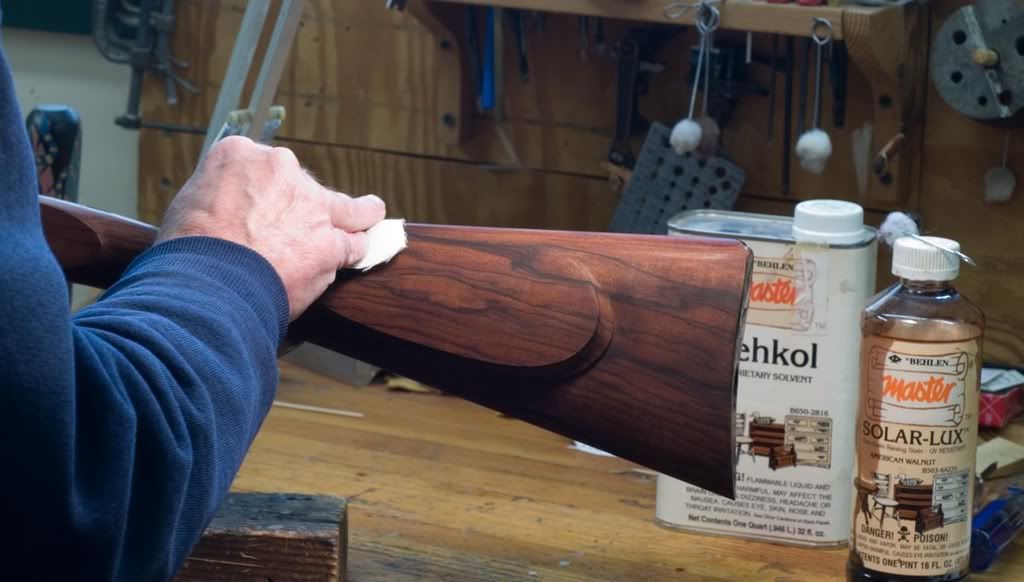|
S |
M |
T |
W |
T |
F |
S |
|
|
|
|
1
|
2
|
3
|
4
|
|
5
|
6
|
7
|
8
|
9
|
10
|
11
|
|
12
|
13
|
14
|
15
|
16
|
17
|
18
|
|
19
|
20
|
21
|
22
|
23
|
24
|
25
|
|
26
|
27
|
28
|
29
|
30
|
31
|
|
|
|
1 members (cable),
607
guests, and
4
robots. |
|
Key:
Admin,
Global Mod,
Mod
|
|
|
Forums10
Topics39,519
Posts562,328
Members14,590
| |
Most Online9,918
Jul 28th, 2025
|
|
|
|
Joined: Dec 2008
Posts: 277 Likes: 5
Sidelock
|

Sidelock
Joined: Dec 2008
Posts: 277 Likes: 5 |
BLO tends to darken with time, it’s quite possible that the blank was wiped down with it years ago.
I use TransTint stains, find them very economical and quiet user friendly. I’ll mix Trans Tint stain with a little bit of alcohol, then mix with BLO (TransTint won’t mix directly with BLO, so I mix it with alcohol first). I’ll use the TransTint/BLO mixture to stain the stock. And use the same mixture when I’m rubbing out the finish…to me it seems to minimize the “burn thru” of the initial staining.
|
|
|
|
|
Joined: Jan 2002
Posts: 606
Sidelock
|

Sidelock
Joined: Jan 2002
Posts: 606 |
I have guns that I stained with Behlen's Solar Lux Blood Red, about ten years ago that I can see absolutely no fading in, at all. The finish over the Behlen's is 15 to 20 coats of TruOil, allowed to dry for 3 days after every second coat, and rubbed out with 400-grit wet-or-dry paper, wetted with boiled linseed oil.
|
|
|
|
|
Joined: Jul 2005
Posts: 2,429 Likes: 35
Sidelock
|

Sidelock
Joined: Jul 2005
Posts: 2,429 Likes: 35 |
David, I did a how-to on stock staining on the Custom Classics page you might do a search for. All staining is a royal PITA, but I consider it necessary. I use Behlens "Am. walnut" that has more browns and gold tones.  
|
|
|
|
|
Joined: Oct 2006
Posts: 131
Sidelock
|

Sidelock
Joined: Oct 2006
Posts: 131 |
SDH:
Where can we find the "Custom Classics page"?
The only constant in life is change.
|
|
|
|
|
Joined: May 2005
Posts: 482
Sidelock
|
OP

Sidelock
Joined: May 2005
Posts: 482 |
I found it, it's here: Gunstock staining by SDH on custom and classic page of this site Thanks very much Steven, that's great. I have some of the american walnut and medium walnut solarlux on the way to me, as well as the blood red that I already have. I'll experiement a bunch and also try mixing--although I didn't like the blood red color at all, I found the stain immediately to be very nice to use and I think very promising for me. Thanks for the tip. I do have a question though--some of the photos of that particular gun look beautifully red (such as the one you re-posted above), while others in the tutorial post look very brown with almost no red tint. I know the photographs and color monitor can hide a lot, any insight into which you feel is a more accurate color representation in most light, and whether the linseed topcoat you used ont hat gun would change the color differently than a benn-matte or other finish?? Any insight into how fade-resistnat it really is over the years?? Thanks again for taking the time to post that--that was exactly what I was looking for.
|
|
|
|
|
Joined: Jul 2005
Posts: 2,429 Likes: 35
Sidelock
|

Sidelock
Joined: Jul 2005
Posts: 2,429 Likes: 35 |
David,
Are the two different looks bench shots versus gray background studio shots? It does look redder when wet & fresh. I think thats the difference; light, camera and wet.
Different top coats will not appreciably change the final color, but any top coat will look different that dry. As for fade resist, I haven't personally tested over time but according to my research, this is the best stain available. They call it Solar-Lux!
Good Luck,
Steve
|
|
|
|
|
Joined: May 2004
Posts: 2,125 Likes: 38
Sidelock
|

Sidelock
Joined: May 2004
Posts: 2,125 Likes: 38 |
For those of you who use Minwax be aware that the red fades out. I have done north facing wood doors and within a year the red is gone although the brown and gold tint in them seem to last. I don't know if a gun is exposed to light enough time to make any difference unless you leave your guns in a glass cabinet.
So many guns, so little time!
|
|
|
|
|
Joined: May 2005
Posts: 482
Sidelock
|
OP

Sidelock
Joined: May 2005
Posts: 482 |
Quick update--I thought some might find this interesting or possibly even useful.
I've been experimenting with the solarlux stuff for the past week or so on various pieces of scrap wood taken from different pieces of english walnut that were sealed and pore-filled exactly as I would a stock, then knocked back to bare wood with 400 grit, stain applied, then a few topcoats over the top of that to see the "finished" color and look.
For what it's worth to those who might try some, here are my observations:
On some wood the medium walnut gives a nice color, but it's more subtle and can quickly look too orange...really tough to strike the right balance between saturated-enough color and too orange. I'm not sold on this color.
The American walnut seems like the best color to use straight, although it really has very little or no red color to it on most of the wood I tried it on--it looks very brown. I liked it on wood that already had some red color in it, but in those cases I probably would not choose to stain it in the first place.
I thought all of these colors looked better as fairly saturated colors, whereas the very subtle tones looked nicer to me, but the color looked more "stained", i.e. not natural...it's hard to describe, but suffice to say that the richer colors looked better to my eye.
I found it harder to get EVEN colors without thinning the stain, so if you try some it seems worth getting the reducer at the same time. My best and most natural-looking colors came from roughly 50/50 or weaker stain/reducer mixes with 3-5 one-wipe applications.
In the interest of achieving that particular "dark with just a hint of red" look I was after, I tried mixing the 2 walnut colors with the blood red. The red very quickly overwhelms the other colors, so while my favorite color yet was the american walnut mixed with the blood red, it only takes a drop of red to do it...my favorite mix was 60/40 reducer and American walnut, total volume about 6 teaspoons, with about 2 DROPS of the red. This was applied in several coats and resulted in a look that was very dark walnutty, but that clearly had just a hint of red in it without any of the "pink" from my previous experiements with the blood red.
Hope this is helpful to someone.
Dave
P.S. Steven--if you read this, can you move the right-hand of the two photos above so it sits under the other pic? My monitor isn't wide enough!
Last edited by David Furman; 03/12/10 11:29 AM.
|
|
|
|
|
Joined: Oct 2006
Posts: 572
Sidelock
|

Sidelock
Joined: Oct 2006
Posts: 572 |
David
Thank You for doing some of the donkey work. I have tried the Solar Lux and the Retarder mixed in at about 7 percent. I found that the stain dries to fast if the retarder is not used. I jsut havent used it in a long time but your post has me wondering if I should give it another try.
Regards, Gordon
Our Dogs make our lives better
|
|
|
|
|